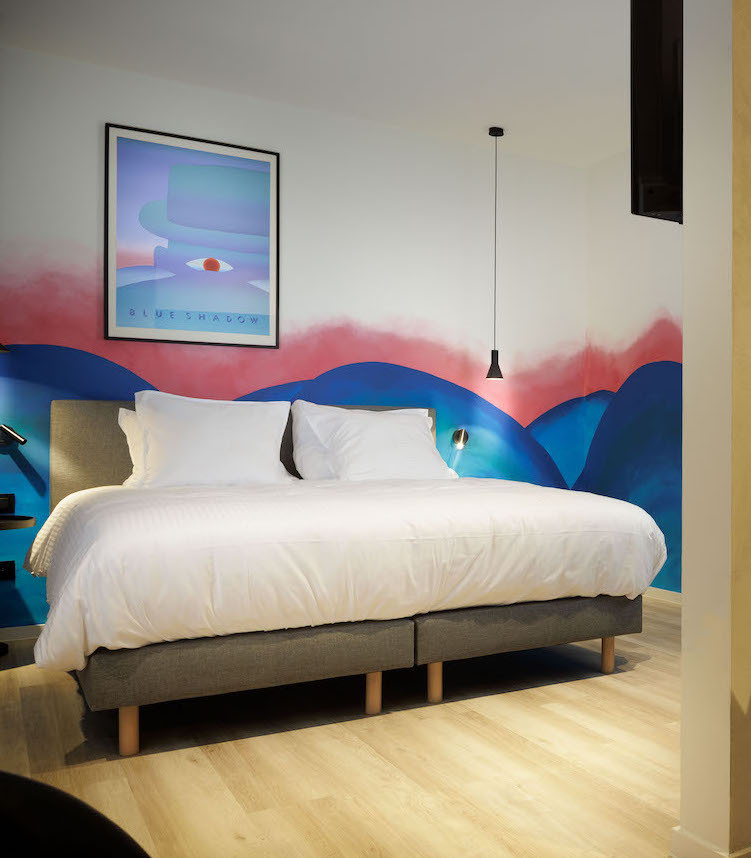

Sustainable
M-Street pulls the environmentally conscious card at all levels with, among other things, its green facade, heat pumps, solar panels and green products

Self Check-In
M-Street has no staffed reception and is fully automated

Late check-out
Thanks to our late check-out, you can fully enjoy the wonderful nightlife that Leuven has to offer

Lively ambiance
M-Street is located just above the renowned café De Libertad, in the middle of the restaurant street of Leuven

Anti allergy
Our rooms have cork floors; a sustainable choice for which no trees are felled
Quite a few art lovers automatically link the term 'poster' to Paris and to the names of Jules Chéret, Henri de Toulouse-Lautrec and Alphonse Mucha.
Nevertheless, poster art has also taken off in Belgium. In 1900, our young but economically prosperous nation even occupied a prominent place on the world stage together with France.
It is no coincidence that the final breakthrough of the poster in Belgium coincided with the breakthrough of Art Nouveau around 1893. The exchange with France was then intense.
One of the Belgian poster art designers who should certainly be mentioned here is Jean-Michel Folon.
He was born in 1934 in Uccle (Brussels). His father was a paper trader, and Jean-Michel grew up in that atmosphere he would always remember: “I probably started drawing there.”
Folon attended the Sint-Lucas art academy and in 1953 he enrolled at the 'École nationale supérieure des Arts visuels de La Cambre', where he discovered the power of architect Mies Van der Rohe's statement: 'Less is more'; an idea he would apply throughout his life. Folon's first black-and-white drawings were published in the magazines Moustique and Pan.
When Folon ended his studies in architecture and left Brussels in 1955, he settled in a garden pavilion in Bougival (Paris), where he devoted himself entirely to drawing for five years.
In the early 1960s he began to show his first drawings to others, but in France there was initially very little interest in his art. He therefore sent his drawings to a number of magazines in New York, which immediately used them as cover designs. It was not until 1964 that Folon had his first exhibition in Paris. During that period Folon met the Italian writer Giorgio Soavi for whom he illustrated his first book 'Le Message'. Together they came up with several projects for the Italian publishing house Olivetti, for whom Folon illustrated books by Franz Kafka and Ray Bradbury.
Unlike the productions of his time – all photographs and typographical material – the artist elaborated a universe of rare cohesion. In his work he created a bizarre world full of strange creatures that represent the fear of time and the alienated human being.
He played with a radical economy of resources, based on the elementary expression of line and the emotional charge of color – colored inks, serigraphs or watercolors, always interspersed with humor and poetry.
In the late 1960s he provided a fresco for the French pavilion at the Milan Triennale, exhibited 60 works at the Galerie de France and exhibited his work for the first time in New York. In the early 1970s, his career took off with exhibitions in New York, Tokyo, Osaka, Vienna and Milan.
At the 12th São Paulo Biennale he received the Grand Prize in Painting.
Folon worked on the most diverse projects in the 1980s. He designed theater sets, made animated movies and shot short films in New York, Los Angeles and New Orleans.
Although his watercolors and etchings were exhibited all over the world in the 1990s, Folon increasingly focused on sculpting: initially in wood, clay and plaster, then in bronze and later in marble. In 1993 he exhibited his sculptures for the first time in La Pedera (Barcelona). In 1997 he placed a sculpture on the coast of Knokke (Belgian coast) that disappears under the water every six hours with the tide.
He also realized stained glass windows and large murals.
In 2000, Folon created the Folon Foundation at the Solvay Domain in La Hulpe. He donated the foundation around 500 works that he had kept in order to unite them in one place. In the years that followed he exhibited his sculptures in Belgium, Lisbon, Pietrasanta and Florence. He made stained glass windows for several churches, became an ambassador for UNICEF and was elevated to the order of the Legion of Honor by the then French president Jacques Chirac. Just after a major retrospective exhibition in the armory of the Palacio Vecchio and in the Forte di Belvedere in Florence, Folon died in 2005 at the age of 71.


Air conditioning
Private bathroom with rain shower
Coffee machine and kettle
Flat-screen TV
Safe
Air conditioning
Private bathroom with rain shower
Coffee machine and kettle
Flat-screen TV
Safe
Minibar (empty)
Shower products
Iron and ironing board
Hair dryer
Desk

